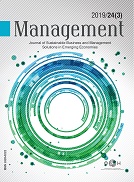A Conceptual Grey Analysis Method for Construction Projects
DOI:
https://doi.org/10.7595/management.fon.2015.0005Abstract
Concerning engineers, project management is a crucial field of research and development. Projects of high uncertainty and scale are characterized by risk, primarily related to their completion time. Thus, safe duration estimations, throughout the planning of a project, are a key objective for project managers. However, traditional linear approaches fail to include and sufficiently serve the dynamic nature of activities duration. On this ground, attention should be paid to designing and implementing methodologies that approximate the duration of the activities during the phase of planning and scheduling too. The grey analysis mathematical modeling seems to gain grounds, since it gradually becomes a well-adapted and up-to-date technique for numerous scientific sectors. This paper examines the contribution of the logic behind the aforementioned analysis, aiming to predict possible future divergences of task durations in big construction projects. Based on time observations of critical instances, a conceptual method is developed for making duration estimations and communicating deviations from the original schedule, in a way that approximations will fit reality better. The whole procedure endeavors to investigate the decrease of uncertainty, regarding project completion time and reduce, up to a scale, a possible inaccurate estimation of a project manager. The utmost effort is about exploiting the gained experience and eliminating the “hedgehog syndrome”. This is attainable by designing a reliable, easily updated, and readable information system. An enlightening example is to be found in the last section.








